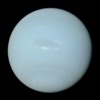 Sao imaged by the Very Large Telescope's FORS1 imager in September 2002 | |
| Discovery[1][2] | |
|---|---|
| Discovered by | |
| Discovery date | August 14, 2002 |
| Designations | |
Designation | Neptune XI |
| Pronunciation | /ˈseɪ.oʊ/ |
Named after | Σαώ Saō |
| S/2002 N 2 | |
| Adjectives | Saonian /seɪˈoʊniən/[3] |
| Orbital characteristics[4] | |
| Epoch June 10, 2003 | |
| 22,228,000 km | |
| Eccentricity | 0.1365 |
| 2912.72 days (7.97 yr) | |
| Inclination | 53.483° |
| Satellite of | Neptune |
| Group | Sao group |
| Physical characteristics | |
| 44 km (for albedo 0.04)[5] | |
| Albedo | 0.04 (assumed)[5] |
Sao /ˈseɪ.oʊ/ is a prograde irregular satellite of Neptune. It was discovered by Matthew J. Holman et al. on August 14, 2002.[6]

Sao orbits Neptune at a distance of about 22.4 million km and is about 44 kilometers in diameter (assuming an albedo of 0.04).[5]
Sao follows an exceptionally inclined and moderately eccentric orbit illustrated on the diagram in relation to other irregular satellites of Neptune. The satellites above the horizontal axis are prograde, the satellites beneath it are retrograde. The yellow segments extend from the pericentre to the apocentre, showing the eccentricity.
The satellite is in Kozai resonance, i.e. its inclination and eccentricity are coupled (the inclination of the orbit decreases while eccentricity increases and vice versa).[6]
Sao, or Neptune XI, like many of the outer satellites of Neptune, is named after one of the Nereids; Sao was associated with sailing and is referred to as "The rescuer" or "Safety". Before the announcement of its name on February 3, 2007 (IAUC 8802), Sao was known provisionally as S/2002 N 2.
References
[edit]- ^ JPL (2011-07-21). "Planetary Satellite Discovery Circumstances". Jet Propulsion Laboratory. Retrieved 2011-10-24.
- ^ Green, Daniel W. E. (January 13, 2003). "Satellites of Neptune". IAU Circular. 8047. Retrieved 2011-10-24.
- ^ Cf. the etymology of Saonia[1]
- ^ Jacobson, R. A. (2008). "NEP078 – JPL satellite ephemeris". Planetary Satellite Mean Orbital Parameters. Retrieved 2009-09-23.
- ^ a b c Sheppard, Scott S.; Jewitt, David C.; Kleyna, Jan (2006). "A Survey for "Normal" Irregular Satellites around Neptune: Limits to Completeness". The Astronomical Journal. 132 (1): 171–176. arXiv:astro-ph/0604552. Bibcode:2006AJ....132..171S. doi:10.1086/504799. S2CID 154011.
- ^ a b Holman, M. J.; Kavelaars, J. J.; Grav, T.; et al. (2004). "Discovery of five irregular moons of Neptune" (PDF). Nature. 430 (7002): 865–867. Bibcode:2004Natur.430..865H. doi:10.1038/nature02832. PMID 15318214. S2CID 4412380. Retrieved 24 October 2011.


